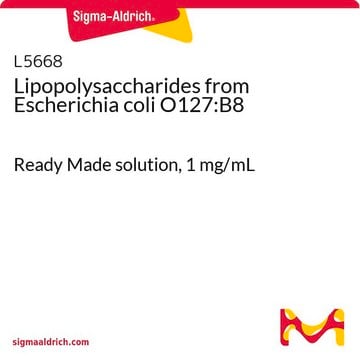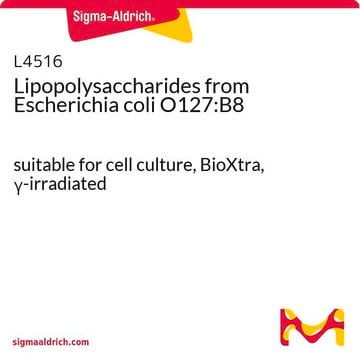L6026
Dodecilsulfatosódico
BioXtra, ≥99.0% (GC)
Sinónimos:
Dodecil sulfato de sodio, Dodecil sulfato sodium salt, Lauril sulfato sodium salt, Laurilsulfato de sodio, SDS
About This Item
Productos recomendados
origen biológico
synthetic (oragnic)
Nivel de calidad
descripción
anionic
Línea del producto
BioXtra
Análisis
≥99.0% (GC)
formulario
powder
mol peso
micellar avg mol wt 18,000
número de agregación
62
impurezas
Insoluble matter, passes filter test
pérdida
≤0.5% loss on drying, HV, 20-25 °C
CMC
7-10 mM (20-25°C)
mp
204-207 °C (lit.)
temperatura de transición
cloud point >100 °C
solubilidad
H2O: 0.1 M, clear, colorless
densidad
0.496 g/cm3
trazas de anión
chloride (Cl-): ≤0.05%
phosphate (PO43-): ≤0.0001%
trazas de catión
Al: ≤0.0005%
Ba: ≤0.0005%
Bi: ≤0.0005%
Ca: ≤0.001%
Cd: ≤0.0005%
Co: ≤0.0005%
Cr: ≤0.0005%
Cu: ≤0.0005%
Fe: ≤0.0005%
K: ≤0.02%
Li: ≤0.0005%
Mg: ≤0.0005%
Mn: ≤0.0005%
Mo: ≤0.0005%
Ni: ≤0.0005%
Pb: ≤0.0005%
Sr: ≤0.0005%
Zn: ≤0.0005%
absorción
≤0.05 at 280 in H2O at 0.1 M
≤0.08 at 260 in H2O at 0.1 M
HLB
40
cadena SMILES
[Na+].CCCCCCCCCCCCOS([O-])(=O)=O
InChI
1S/C12H26O4S.Na/c1-2-3-4-5-6-7-8-9-10-11-12-16-17(13,14)15;/h2-12H2,1H3,(H,13,14,15);/q;+1/p-1
Clave InChI
DBMJMQXJHONAFJ-UHFFFAOYSA-M
¿Está buscando productos similares? Visita Guía de comparación de productos
Descripción general
Aplicación
- surfactant to evaluate cytochrome c affinity by using surface plasmon resonance
- surfactant in particle enhanced immunoassays to inhibit aggregation of particles and to enhance single microsphere coupling
- biofilm-disrupting agent
Características y beneficios
- Tested to confirm low levels of heavy metal contamination, ensuring suitability for various applications
- Tested for trace levels of Anions and Cations
- High-purity product ideal for biochemical research purposes
Otras notas
producto comparable
Palabra de señalización
Danger
Frases de peligro
Consejos de prudencia
Clasificaciones de peligro
Acute Tox. 4 Oral - Aquatic Chronic 3 - Eye Dam. 1 - Skin Irrit. 2
Código de clase de almacenamiento
11 - Combustible Solids
Clase de riesgo para el agua (WGK)
WGK 2
Punto de inflamabilidad (°F)
338.0 °F
Punto de inflamabilidad (°C)
170 °C
Equipo de protección personal
Eyeshields, Faceshields, Gloves, type P3 (EN 143) respirator cartridges
Choose from one of the most recent versions:
Certificados de análisis (COA)
Don't see the Right Version?
If you require a particular version, you can look up a specific certificate by the Lot or Batch number.
¿Ya tiene este producto?
Encuentre la documentación para los productos que ha comprado recientemente en la Biblioteca de documentos.
Los clientes también vieron
Nuestro equipo de científicos tiene experiencia en todas las áreas de investigación: Ciencias de la vida, Ciencia de los materiales, Síntesis química, Cromatografía, Analítica y muchas otras.
Póngase en contacto con el Servicio técnico





